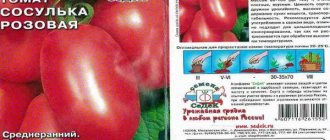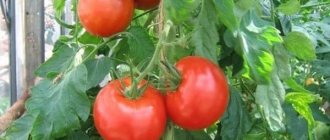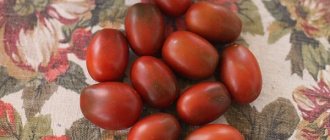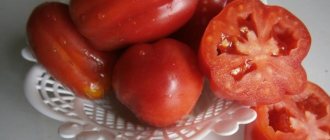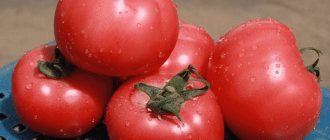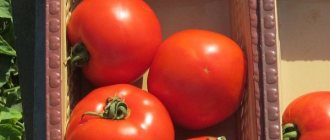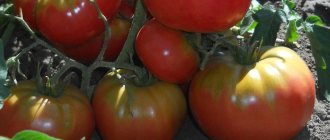Description of the hybrid
Shedy Lady f1 is a hybrid from the Dutch seed company Nunhems . Included in the State Register of the Russian Federation in 2005. Bred for cultivation in garden plots, household plots and small farms in open ground. The plant is determinate and bears fruit early. Decorative bushes, leafy, with a strong root system.
In the photo - Shady Lady tomatoes f1.
Distinctive features
The table shows the characteristics of the tomato:
| Indicators | Characteristic |
| Weight | 160–200 g |
| Form | Round |
| Coloring | Red |
| Leaves | Large, rich green color |
| Type of inflorescences | Simple |
| peduncle | Without articulation |
| Number of slots | Four or more |
| Pulp | Juicy but not watery |
| Taste | Sweet, pleasant |
| Skin | Dense, smooth, does not crack |
| Purpose | Salad tomatoes |
| Bush height | 60–70 cm |
| Ripening period | 105–115 days from sowing |
| Productivity | 7.5 kg/m² |
| Sustainability | To verticillium, fusarium, cladosporiosis, tobacco mosaic virus. |
| Transportability | High |
Shedy Lady - the best early ripening tomato
Growing seedlings
Work with seed material begins in early March , 55–60 days before the planned transfer of seedlings to the garden.
Preparing the soil and sowing seeds
Hybrid seeds are not soaked in antibacterial solutions , since they have already been treated before packaging. To speed up germination, the material is soaked for 12 hours in growth stimulating agents: “Kornevine”, “Novosile”, “Eco-gel”.
Seeds are planted in a light substrate consisting of turf, garden soil and rotted humus in a ratio of 1:1:1. The soil is pre-disinfected in the oven, microwave or filled with a solution of potassium permanganate.
A layer of soil is poured into a container 5–7 cm high , furrows of 1–1.5 cm are made, seeds are laid out at a distance of 2 cm and watered with warm water. Stretch the film over the top and place it in a dark, warm place. Treated seeds will hatch faster at a temperature of +23 °C.
Seedling care
After the sprouts appear, the film is removed and the seedlings are placed on a sunny windowsill on the south side or placed under a phytolamp. It is important to organize long daylight hours to prevent the seedlings from stretching out into growth.
Picking into individual cups is carried out after the appearance of 2 true leaves. Plants are fertilized once before planting in the ground with mineral preparations (Azofoskaya, Krepysh, Agricola, Kemira Combi), according to the instructions on the package.
Water after the top layer of soil has completely dried.
10 days before planting in open ground, seedlings are accustomed to fresh air. To do this, the cups are taken out onto the balcony. For the first time, 15 minutes is enough. Every day the time is increased by 5–10 minutes.
Tomato variety with seedling cultivation method - Radunitsa tomato: description and characteristics
Radunitsa is a beautiful orange tomato with bright color and good taste. This variety can be grown in open ground and greenhouses and is considered one of the best orange-fruited tomatoes of domestic selection obtained recently.
| Height | Landing location | Ripening time | Fruit color | Fruit size | Origin | Fruit shape |
| Tall | Open ground | Mid-season | Yellow | Large | Variety | Plum-shaped or oval |
Description and characteristics of the variety
Tomato Radunitsa is a yellow or orange variety that can be grown in all regions. The cultivar was included in the Register in 2008. The author of the variety is the famous breeder Dederko V. N. The variety is intended for cultivation on private plots.
The bush is indeterminate and requires staking and shaping. The purpose of the fruit is salad. In terms of ripening time, Radunitsa is a mid-ripening tomato; 100-115 days pass from germination to harvest.
Unripe fruits are green, mature ones are intense yellow. Average weight is 200 g. The shape is obovate, the surface is smooth. The pulp is medium dense, there are 4-6 seed chambers.
Advantages and disadvantages
- the fruits are large, fleshy, bright, beautiful;
- amazingly balanced taste, which makes tomatoes excellent in summer salads;
- increased content of sugar and valuable substances in fruits, which makes them suitable for children's and dietary nutrition.
Minuses:
tall stems have to be tied securely so that they do not break under the weight of the fruit.
Productivity
At state tests, a yield of 13 kg per 1 sq. m. For a varietal tomato, this is a fairly high figure. If you do not cover the seedlings with film, but plant them later, when the threat of spring temperature drops has disappeared, the plants will not have time to set all the fruits and the yield will drop to 10-11 kg. On average, about 3 kg is removed from a bush.
Features of cultivation and storage
Radunitsa is planted only as seedlings, sowing the seeds 60 days before transferring the seedlings to a permanent place. For 1 sq. m, place 3-4 plants and form them into 1-2 stems with a garter and pinching.
The variety is highly dependent on watering and fertilizing with complex mineral fertilizers. To accelerate germination and better fruit set, special growth and development stimulants are used:
Planting and care
Before sowing, the seeds are soaked in water for 24 hours and then sown to a depth of 1 cm according to a 3x1.5 cm pattern.
After the appearance of the 2nd true leaf, picking is carried out.
To increase the weight of the fruit and increase the overall yield, you need to tear off all the stepsons, not allowing them to grow more than 2 cm. After collecting the fruits from the next cluster, the lower leaves must be removed so that all the nutrients can rise higher - to the next tomato bunch.
Tomato cultivation
Planting in the garden begins at the end of May . By this time, the threat of frost will have disappeared, and the soil will have warmed up thoroughly.
Landing
carrots, beets, cabbage, onions, beans or spinach previously grew In autumn, the soil is dug up and fertilized with bird droppings, ash, compost or humus at a rate of 5 kg per 1 m². The best mineral fertilizers are potassium salt (20–25 g per 1 m²) and superphosphate (40–50 g per 1 m²).
In the first ten days of May, the soil is dug up again and fertilizing mixed in equal parts is applied to a depth of 15 cm: 1.5 kg of wood ash, 25 g of ammonium sulfate and 1 kg of bird droppings per 1 m².
Holes for seedlings are dug at a depth of 15 cm and spilled with a hot solution of potassium permanganate. The soil in the containers is moistened abundantly so that the seedlings can be removed without any problems. The lower leaves are torn off and, together with the earthen lump, transferred into the hole.
6-7 seedlings are planted per 1 m² at a distance of 70 cm and watered with warm, settled water.
The soil is mulched with straw or sawdust in a 10 cm layer . The plantings are covered with film and left to take root in the new location for 8–10 days. A hole is made in the film to prevent the risk of late blight infection in the created greenhouse conditions.
About other varieties of tomatoes:
We’ll tell you and show you how to grow the “Explosion” tomato
“Little Red Riding Hood” tomatoes, popular among summer residents
Pros and cons of the hybrid tomato Snowman F1
Care
Tomato care is standard and includes weeding, weed removal, watering, loosening, and fertilizing.
10 days after planting, the plants are watered at the root with warm water. Do this once a week, in the evening. With the onset of heat, the soil is moistened every 2-3 times every 7 days.
Hilling is carried out as the bushes grow to strengthen the rhizome.
Tomatoes are fertilized once every 10 days according to the following scheme::
- 2 weeks after planting - 1 part mullein per 10 liters of water.
- Subsequent fertilizing is potassium-phosphorus - 60 g of nitrophoska per 10 liters of water.
Before flowering, the consumption per bush is 1 liter, after - 2–5 liters.
Forming bushes into 2 stems significantly increases productivity . The stepsons are carefully broken out or cut off with a sharp knife.
Important! 10 days after planting, the bushes are tied to low stakes to prevent the stems from breaking under the weight of the tomatoes.
Prevention of diseases and pests
tomatoes are resistant to nightshade diseases : verticillium, fusarium, cladosporiosis, tobacco mosaic virus (TMV).
To prevent late blight (brown spots on leaves, stems and fruits), the bushes are regularly irrigated:
- fungicides: “Previkur”, “Fitosporin”, “Quadris”, “Topaz”, “Chorus”, “HOM”, as well as Bordeaux mixture, copper sulfate, according to the instructions;
- infusion of garlic with potassium permanganate (100 g of chopped garlic cloves, pour 250 ml of water, leave for 24 hours, bring the volume to 10 l and add 1 g of potassium permanganate);
- yeast solution (dilute 80 g of pressed yeast in 10 liters of water);
- a solution of milk with iodine (add 1 liter of low-fat milk and 20 drops of iodine to 10 liters of water);
- whey diluted with water in a 1:1 ratio.
Bushes are treated with folk remedies before flowering , then every 10–14 days. The use of chemicals is stopped 2 weeks before the start of harvest.
Preventive measures will help prevent infection:
- mulching beds with peat, sawdust, pine needles;
- spring disinfection of soil with copper sulfate (100 g of dry matter per 10 liters of water);
- compliance with the irrigation regime in order to prevent excess moisture in the soil;
- timely application of potassium-phosphorus fertilizers.
cope with aphids, whiteflies , and spider mites :
- modern insecticides: “Commander”, “Iskra”, “Intavir”;
- biological products: “Fitoverm”, “Biotlin”, “Strela”.
Among folk remedies, the most effective are considered:
- Garlic infusion. To prepare it, add 400 g of finely chopped garlic arrows to 1 liter of warm water and leave for 4-5 days. The bushes are treated 3 times during the entire growing season, every 3 days.
- Ash. Add 50 g of ash to 10 liters of water, stir and filter through cheesecloth. Then pour in 50 ml of liquid soap. Apply the solution to spray the bushes on an ongoing basis every 14 days.
- Infusion of tobacco. Add 200 g of shag to 5 liters of warm water and leave for 48 hours. The plants are treated with the liquid 3-4 times with an interval of 3 days.
are sown between the beds to attract ladybugs that prey on aphids.
Description of the Shady Lady tomato and recommendations for growing a hybrid variety
Shedy Lady is a tomato that is characterized by early ripening and high yield. Owners of summer cottages pick the first fruits 2 months after planting the crop. The designation F1 in the variety name indicates that the tomato is a first generation hybrid. Tomato Shady Lady F1 was bred by Dutch breeders.
It combines the best qualities of other varieties, but its seeds cannot be used for planting next season. It is convenient that tomato can grow in almost all regions of our country. Reviews that can be found on the Internet report that this vegetable crop is unpretentious to weather conditions.
What is a Shady Lady tomato?
Many gardeners start planting in the garden with the Shedi Lady tomato. It is planted in early May in greenhouses or a little later in open ground. The plant can be grown both in greenhouses and outdoors.
Characteristics and description of the variety:
- The variety is determinant, that is, it has a height limit.
- Usually the plant grows to 60-70 cm.
- Decorative bush with wide powerful bright green leaves.
- Experienced gardeners advise forming no more than two stems per bush.
- The first fruits appear approximately 60 days after the plant is planted in the ground.
- Tomatoes grow in clusters.
- There can be 4-6 tomatoes on one branch.
The tomatoes are round and smooth. The color is rich red. The average weight of one tomato is about 150-200 g. The fruits are quite large. The pulp is juicy and sweetish.
Shady Lady tomatoes are believed to contain a lot of sugar, beneficial minerals and vitamins.
Tomatoes are a source of B vitamins, thanks to which the body produces serotonin (the hormone of happiness), improves the functioning of the heart and digestive organs.
https://youtube.com/watch?v=WosW2hZX6x0
The fruits have a thick skin. Tomatoes are not subject to cracking and are not watery. The Shady Lady tomato is a salad tomato. Usually it is not stored for the winter. Taste qualities are best revealed when fresh. But the fruits are not suitable for canning due to their large size.
Dishes that can be prepared from Shedi Lady tomatoes:
- various salads;
- pasta or pizza sauce;
- shakshuka (eggs with tomatoes and spices);
- fresh snacks;
- stew;
- casseroles.
Several facts make the Shady Lady F1 tomato popular among garden and vegetable garden owners. Advantages of the variety:
- The variety is not susceptible to weather and is resistant to temperature changes. Tolerates dry weather calmly.
- Tomato is not susceptible to most common diseases. Resistant to pests.
- Can withstand transportation over long distances without problems. Due to the dense peel, the fruits remain intact and beautiful.
- They have excellent taste. They are rich in useful substances. They can ripen indoors and be stored for a long time.
- The Shedi Lady variety has good yield. From 1 m², on which from 5 to 7 bushes can grow, 7-8 kg of tomatoes are harvested.
How to grow tomatoes
Seedlings are planted in early March. A nutritious mixture of humus, peat and soil is poured into boxes or containers. The seeds are pre-soaked for 12 hours in a solution that stimulates the growth of vegetable crops. The container should be in a warm room. This way the shoots will appear faster. Approximately this should happen 7-10 days after planting.
After the seeds germinate, the containers are placed closer to the light: either on the windowsill or under lamps. It is necessary for plants to fully develop. Picking into separate cups is carried out as soon as the first strong leaves appear.
Experts advise hardening off grown seedlings. For the first time, you can take it out into the fresh air or open a window in the room for 5 minutes. Next time at 10, then at 15. This way the tomatoes will get used to the street.
Planting in closed ground takes place in early May. To the open garden - after a few weeks. The soil should be prepared: water it with potassium permanganate, sprinkle it with fertilizers, ash and loosen it well.
5-7 bushes are planted per 1 m². Caring for the Shedi Lady tomato is easy. It is periodically watered with warm, settled water, fed, the soil is loosened, partially covered, and tied to a support.
To get maximum yield, leave 2 stems at the bush. Leaves are selectively removed to normalize air circulation. The greenhouse in which the Shady Lady F1 tomato grows is ventilated. This will eliminate the possibility of fungus appearing.
Experienced summer residents advise planting tomatoes next to fragrant herbs, for example, basil and parsley. The smell reduces the number of harmful insects. Tomatoes go well with garlic and onions. These crops protect tomatoes from late blight and mites.
Features of growing in greenhouses
Some gardeners are of the opinion that it is irrational to take up space in a greenhouse with spreading determinate bushes: the Shedi Lady hybrid is intended for growing primarily in open ground.
Nevertheless, the culture feels great in greenhouse conditions. Planting of seedlings begins in early May . The soil is first loosened, holes 10–15 cm deep are dug, disinfected with a hot solution of potassium permanganate and 1 tbsp is added. l. ash in each of them. The bushes are watered with warm, settled water.
No more than 6 seedlings are planted per square meter . Caring for the crop is standard and includes regular watering, loosening the soil, pinching with staking of stems and applying the same fertilizers as when grown in open ground.
It is important to carefully monitor the condition of the bushes and begin treatment at the slightest sign of late blight, because high humidity in a greenhouse is an ideal environment for the proliferation of late blight. When grown outdoors, the problem can often be avoided.
Preventive measures will help prevent or minimize the scale of infection in a greenhouse :
- autumn treatment with sulfur bombs;
- removing the top layer of soil (5–10 cm);
- spring disinfection of soil with copper sulfate (100 g of substance per 10 l, consumption - 2 l/m²);
- mulching the beds with sawdust, pine needles, peat after planting;
- moderate watering.
Difficulties in growing the crop indoors relate to pollination , since insects do not have easy access to the flowers. To do this, hives with bees are placed in the greenhouse or a fan is installed. The bushes are periodically shaken or lightly tapped on the stems with a stick so that the pollen does not fall off. After this, the soil is moistened and the flowers are sprayed with water.
Advantages and disadvantages
Advantages of the Shedi Lady hybrid:
- resistance to adverse weather conditions (heat, sudden temperature changes);
- immunity to nightshade viral diseases;
- possibility of transportation over long distances without loss of commercial qualities;
- dense skin, not prone to cracking;
- wonderful taste;
- possibility of ripening outside the bush;
- high yield.
The only disadvantages include the need for pinching and the formation of a bush with 2 stems to obtain large harvests.
Reviews
Reviews of Shady Lady tomatoes are mostly positive. Gardeners note the crop’s strong immunity to various viral diseases and ease of care:
Vera, Vyazma : “I am growing tomatoes at the dacha in open ground. From time to time I try new varieties and hybrids. Last year I became interested in Shedy Lady f1. I read reviews online and got to work. The seeds were soaked in a growth stimulant, resulting in 100% germination. Strong seedlings were planted in separate peat cups. Planted in the last ten days of May. The bushes were fertilized abundantly with phosphorus and potassium and watered in moderation. There were no particular problems with cultivation.”
Stanislav, Kurchatov : “Shedi Lady tomatoes are one of my favorites to grow in the garden. The culture is unpretentious in care, resistant to diseases and heat. The harvest is consistently high, the fruits are tasty and sweet.”
Disease and insect control
Tomato Shady Lady is characterized by high immunity to the following diseases:
For preventive purposes, it is advisable to constantly treat tomato bushes with special copper-containing preparations. Phytosporin or a weak solution of manganese will help get rid of crown, gray and root rot. Harmful parasites must be dealt with immediately after detection.
To do this, you can use traditional methods to combat aphids:
- The karbofos solution is low-toxic, does not harm the plant, and acts on aphids for several days.
- Soap solution with sifted ash. It acts not only as a top dressing, but also helps get rid of pests and aphids on plants.
- Tobacco infusion. Its pungent aroma repels and destroys pests from tomatoes. To make it, add 350 g of tobacco to a liter of boiling water. Boil for about half an hour, then strain and dilute in 10 liters of water. In the evening, treat the plants and take a five-day break.
- Potatoes are considered a strong remedy against bugs, aphids, larvae, and caterpillars. To prepare such a solution, you need to chop the potato tops and add cold water (10 l). Leave for several hours, then process the tomatoes. After the procedure, the pests will disappear in 2–3 hours.
To combat insects, you can use insecticides, but it is not recommended to use them during the fruiting period - consuming such tomatoes can negatively affect your health. With proper care, the characteristics of this tomato variety are extremely positive.
